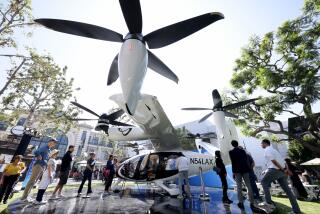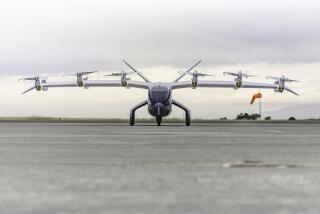Private planes to fly at public prices
Flying in a private jet has been typically reserved for the privileged few who can easily drop $20,000 for a weekend ski trip to Aspen, Colo.
But two Santa Monica High School graduates are starting a no-frills discount “air taxi” service that could allow more people to join the jet set.
Next year, the company, JetAviva, will begin offering seats on a new line of small planes that it says will bring airline affordability to the private-jet experience.
For about the price of first-class airline travel, a party of three can drive right onto the tarmac at Van Nuys Airport, hop on one of JetAviva’s Eclipse 500 jets and be in Las Vegas in 45 minutes, avoiding airport security, airline schedules and, of course, strangers. Travelers rent the entire four-passenger plane rather than a seat at a time.
“It’ll be like flying in your own private jet but at airline prices,” said Cyrus Sigari, who founded the Van Nuys-based company 18 months ago with his boyhood friend Ben Marcus.
Both are barely 25 years old, but the West Los Angeles natives are hoping to be at the cusp of an emerging industry thanks to the development of small jets that are selling at a fraction of the cost of the current generation of private jets.
Known as Very Light Jets, or VLJs, the planes can seat as many as five passengers and range in price from $1.6 million to $3 million. That’s far below conventional private jets, which can cost from $9 million for a six-passenger Learjet to $50 million for a 16-seat Gulfstream G-550.
Because of the low cost of the airplane and what promises to be lower operating cost, the company can pass along the savings and offer private jet service to a wider range of business travelers and individuals, Marcus said.
“It’ll be 30% to 50% cheaper than chartering a private jet,” Marcus said, though the exact rate schedule is still being worked out. The planes can also fly to more airports than airliners, virtually all of the 10,000 general aviation airstrips that dot the U.S., Marcus added.
For the moment, the company is managing Eclipse jets for private owners who don’t have time to maintain them on their own. It also provides training for the owners who need a special certification to fly the jets and has pilots who will fly with the owners until they get the certificate.
The company is part of a new cottage industry being fueled by the advent of Very Light Jets.
DayJet, an air taxi service using the Eclipse 500 jets, began operations in Florida last month, flying passengers between places such as Boca Raton, Lakeland and Tallahassee. The company, the first of its kind, has ordered more than 400 of the Eclipse 500 jets, which sell for nearly $1.6 million each.
But JetAviva doesn’t plan to buy any of the planes itself. Instead it is relying on a time-tested arrangement used by traditional private jet charter services.
The company currently manages three planes for their owners, who in turn have agreed to allow the company to use the planes for the air-taxi service. The company expects to have two to six more new Eclipse jets under management by the time the service begins with a total of 15 by the end of 2008. Sigari estimates that the Eclipse owners typically fly their planes only about seven days out of the month. The rest of the time, the jets sit in a hangar.
But the upkeep can be significant for Eclipse owners, who are typically well off but not super-rich like those owning the more expensive jets.
Maintaining and flying the plane can cost more than $125,000 a year for the average Eclipse owner, an expensive hobby even for a plastic surgeon or a retired executive, who make up the typical Eclipse owner profile.
“They pay me for the use of the airplane, which helps pay my cost” of maintaining the plane, said Ron Lebel, a Sherman Oaks resident and former executive for a medical equipment maker who recently bought an Eclipse 500.
Inseparable since childhood, Sigari and Marcus went to work for Eclipse Aviation after graduating from Purdue University, where Sigari got a degree in aerospace engineering and Marcus in aviation technology.
At Eclipse, the New Mexico-based maker of the aircraft bearing its name, Sigari and Marcus helped design, test, fly and sell the light jets. After a couple of years, the two decided to start their own company, something they had dreamed about since they were 14 years old.
Fascinated with aviation, they had begun taking flying lessons at Santa Monica Airport when they were 12 years old. When they turned 14, they attempted to start their own airline, which would have flown passengers between Los Angeles and Santa Catalina Island. Their parents grounded the idea.
While working at Eclipse, Sigari and Marcus figured there was a business opportunity in the day-to-day management of the jets for their owners.
“The service wasn’t being provided by anyone else,” Sigari said.
Barely 24 at the time, the two pooled their personal savings and began mapping a strategy for the start- up, including parlaying their Eclipse experience into drawing their first customers.
“They’re building a business around managing and operating these airplanes,” said Michael McConnell, vice president of marketing for Eclipse who had worked with Sigari and Marcus.
The planes are starting to roll in now, but there were some trying times.
Sigari and Marcus started the company in February 2006 expecting Eclipse to begin delivering its first planes within five months. But it would take 11 more months before Eclipse, hit with production delays, began the initial deliveries to its first buyers.
The pace of deliveries was also much slower than they had expected, so for about a year the two friends worked as aviation consultants to make ends meet.
“In the down time we worked on building our customer base, developing our systems and processes, and doing a number of aviation consulting jobs on the side to keep us from having to bring in investors,” Sigari said.
There was also the matter of age, and their boyish looks. Most of their potential clients are decades older.
“They’re trying to overcome their own youth but sometimes it takes that youthful energy to start and grow a business,” McConnell said.
Lebel, who flies his plane about once a week, said the age of the two company owners didn’t deter him from signing up for the program.
“I’ve been flying longer than they’ve been alive,” Lebel said. “I’m quite aware that 50% of new businesses fail, so these guys have a lot to learn. But I think they are capable of dealing with the challenges. They’re determined and smart.”
There may be another obstacle that youthfulness can’t overcome: The planes don’t have bathrooms, an inconvenience that may deter potential customers.
Sigari said he wasn’t worried. “Most of the flights that we expect to do are on the order of one hour of flying time,” he said, “which should help mitigate the bathroom issue.”
--
(BEGIN TEXT OF INFOBOX)
JetAviva
Business: Helps owners maintain and operate Eclipse private jets
Owners: Cyrus Sigari and Ben Marcus
Employees: 10, including five pilots
Headquarters: Van Nuys
Next: Plans to launch a no-frills air taxi service in 2008
Goal: To be the largest operator of managed Very Light Jets
More to Read
Inside the business of entertainment
The Wide Shot brings you news, analysis and insights on everything from streaming wars to production — and what it all means for the future.
You may occasionally receive promotional content from the Los Angeles Times.










